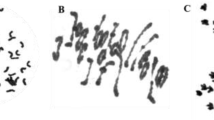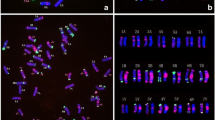Abstract
Aegilops geniculata Roth is an important germplasm resource for the transfer of beneficial genes into common wheat (Triticum aestivum L.). A new disomic addition line NA0973-5-4-1-2-9-1 was developed from the BC1F6 progeny of the cross wheat cv. Chinese Spring (CS)/Ae. geniculata SY159//CS. We characterized this new line by morphological and cytogenetic identification, analysis of functional molecular markers, genomic in situ hybridization (GISH), fluorescence in situ hybridization (FISH), and disease resistance evaluation. Cytological observations suggested that NA0973-5-4-1-2-9-1 contained 44 chromosomes and formed 22 bivalents at meiotic metaphase I. The GISH investigations showed that the line contained 42 wheat chromosomes and a pair of Ae. geniculata chromosomes. EST-STS multiple loci markers and PLUG (PCR-based landmark unique gene) markers confirmed that the introduced Ae. geniculata chromosomes belonged to homoeologous group 7. FISH identification suggested that NA0973-5-4-1-2-9-1 possessed an additional pair of 7Mg chromosomes, and at the same time, there were structural differences in a pair of 6D chromosomes between NA0973-5-4-1-2-9-1 and TA7661 (CS-AEGEN DA 7Mg). After inoculation with powdery mildew (Blumeria graminis f. sp. tritici, Bgt) isolates E09, NA0973-5-4-1-2-9-1 exhibited a powdery mildew resistance infection type different from that of TA7661, and we conclude that the powdery mildew resistance of NA0973-5-4-1-2-9-1 originated from its parent Ae. geniculata SY159. Therefore, NA0973-5-4-1-2-9-1 can be used as a donor source for introducing novel disease resistance genes into wheat during breeding programs with the assistance of molecular and cytogenetic markers.





Similar content being viewed by others
References
An DG, Zheng Q, Zhou YL, Ma PT, Lv ZL, Li LH, Li B, Luo QL, Xu HX, Xu YF (2013) Molecular cytogenetic characterization of a new wheat–rye 4R chromosome translocation line resistant to powdery mildew. Chromosome Res 21:419–432
Bochev B, Christova S, Doncheva V (1982) The genus Aegilops possibilities and perspectives of utilization in the breeding of high quality wheat cultivars. In: Proceedings VII world cereal and bread congress, Prague
Chen GL, Zheng Q, Bao YG, Liu SB, Wang HG, Li XF (2012) Molecular cytogenetic identification of a novel dwarf wheat line with introgressed Thinopyrum ponticum chromatin. J Biosci 37:149–155
Doyle JJ, Doyle JL (1987) A rapid DNA isolation procedure for small quantities of fresh leaf tissue. Phytochem Bull 19:11–15
Du WL, Wang J, Liu M, Sun SG, Chen XH, Zhao JX, Yang QH, Wu J (2013) Molecular cytogenetic identification of a wheat–Psathyrostachys huashanica Keng 5Ns disomic addition line with stripe rust resistance. Mol Breeding 31:879–888
Friebe BR, Heun M (1989) C-banding pattern and powdery mildew resistance of Triticum ovatum and four T. aestivum–T. ovatum chromosome addition lines. Theor Appl Genet 78:417–424
Friebe BR, Jiang J, Raupp WJ, McIntosh RA, Gill BS (1996) Characterization of wheat–alien translocations conferring resistance to diseases and pests: current status. Euphytica 91:59–87
Friebe BR, Tuleen NA, Gill BS (1999) Development and identification of a complete set of Triticum aestivum–Aegilops geniculata chromosome addition lines. Genome 42:374–380
Fu SL, Yang MY, Ren ZL, Yan B, Tang ZX (2014) Abnormal mitosis induced by wheat–rye 1R monosomic addition lines. Genome 57:21–28
Fu SL, Chen L, Wang YY, Li M, Yang ZJ, Qiu L, Yan BJ, Ren ZL, Tang ZX (2015) Oligonucleotide probes for ND-FISH analysis to identify rye and wheat chromosomes. Sci Rep. doi:10.1038/srep10552
Gill BS, Sharma HC, Raupp WJ, Browder LE, Hatchett JH, Harvey TL, Moseman JG, Waines JW (1985) Evaluation of Aegilops species for resistance to powdery mildew, wheat leaf rust, Hessian fly, and greenbug. Plant Dis 69:314–316
Han FP, Lamb JC, Birchler JA (2006) High frequency of centromere inactivation resulting in stable dicentric chromosomes of maize. Proc Natl Acad Sci USA 103:3238–3243
Heslop-Harrison JS (2000) Comparative genome organization in plants: from sequence and markers to chromatin and chromosomes. Plant Cell 12:617–636
Hu LJ, Li GR, Zeng ZX, Chang ZJ, Liu C, Yang ZJ (2011) Molecular characterization of a wheat–Thino-pyrumponticum partial amphiploid and its derived substitution line for resistance to stripe rust. J Appl Genet 52:279–285
Ishikawa G, Nakamura T, Ashida T, Saito M, Nasuda S, Endo TR, Wu JZ, Matsumoto T (2009) Localization of anchor loci representing five hundred annotated rice genes to wheat chromosomes using PLUG markers. Theor Appl Genet 118:499–514
Kilian B, Mammen K, Millet E, Sharma R, Graner A, Salamini F, Hammer K, Özkan H (2011) Aegilops. In: Kole C (ed) Wild crop relatives: genomic and breeding resources, pp 1–76
Kong LN, Li Q, Wang HY, Cao AZ, Chen PD, Wang XE (2008) Molecular marker analysis of wheat–Roegneria ciliaris additions lines. Hereditas 30:1356–1362
Kuraparthy V, Chhuneja P, Dhaliwal HS, Kaur S, Bowden RL, Gill BS (2007) Characterization and mapping of cryptic alien introgression from Aegilops geniculata with new leaf rust and stripe rust resistance genes Lr57 and Yr40 in wheat. Theor Appl Genet 114:1379–1389
Leitch IJ, Heslop-Harrison JS (1992) Physical mapping of the 18S-5.8 S-26S rRNA genes in barley by in situ hybridization. Genome 35:1013–1018
Li GP, Chen PD, Zhang SZ, Wang X, He ZH, Zhang Y, Zhao H, Huang HY, Zhou XC (2007) Effects of the 6VS. 6AL translocation on agronomic traits and dough properties of wheat. Euphytica 155:305–313
Li H, Guo XX, Wang CY, Ji WQ (2015) Spontaneous and divergent hexaploid Triticales derived from common wheat × Rye by complete elimination of D-genome chromosomes. PLoS One 10(3):e0120421. doi:10.1371/journal.pone.0120421
Mettin D, Blüthner WD, Schäfer HJ, Buchholz U, Rudolph A (1977) Untersuchungen an Samenproteinen in der Gattung Aegilops. Tagungsber Akad Landwirtschaftswiss DDR 158:95–106
Mohler V, Bauer C, Schweizer G, Kempf H, Hartl L (2013) Pm50: a new powdery mildew resistance gene in common wheat derived from cultivated emmer. J Appl Genet 54:259–263
Rayburn AL, Gill BS (1986) Isolation of a D-genome specific repeated DNA sequence from Aegilops squarrosa. Plant Mol Biol Rep 4:102–109
Riley RV, Chapman V, Johnson R (1968) The incorporation of alien disease resistance in wheat by genetic interferences with regulation of meiotic chromosome synapsis. Genet Res 12:199–219
Sears ER (1956) The transfer of leaf-rust resistance from Aegilops umbellulata to wheat. Genetics in plant breeding. Brookhaven Symp Biol 9:1–22
Sheng B (1988) Grades of resistance to powdery mildew classified by different phenotypes of response in the seeding stage of wheat. Plant Prot 1:49
Siddiqui KA, Yosufzai MN (1988) Natural and induced variation for endomorphic traits in the tribe Triticeae. In: Proceedings 7th international wheat genetics symposium, Cambridge, pp 139–144
Taketa S, Takeda K (2001) Production and characterization of a complete set of wheat–wild Barley (Hordeum vulgare ssp. spontaneum) chromosome addition line. Breed Sci 51:199–206
Tang ZX, Yang ZJ, Fu SL (2014) Oligonucleotides replacing the roles of repetitive sequences pAs1, pSc119.2, pTa-535, pTa71, CCS1, and pAWRC.1 for FISH analysis. J Appl Genet 55:313–318
Van Slageren MW (1994) Wild wheats: a monograph of Aegilops L. and Amblyopyrum (Jaub & Spach) Eig (Poaceae). Agricultural University, Wageningen-ICARDA, Aleppo, p 512
Wang G, Ji J, Wang YB, Hu H, King IP, Snape JW (1993) The genetic characterization of novel multi-addition doubled haploid lines derived from triticale × wheat hybrids. Theor Appl Genet 87:531–536
Wang D, Zhuang LF, Sun L, Feng YG, Pei ZY, Qi ZJ (2010) Allocation of a powdery mildew resistance locus to the chromosome arm 6RL of Secale cereale L. cv. ‘Jingzhouheimai’. Euphytica 176:157–166
Wang YJ, Wang CY, Quan W, Jia XJ, Fu Y, Zhang H, Liu XL, Chen CH, Ji WQ (2016) Identification and mapping of PmSE5785, a new recessive powdery mildew resistance locus, in synthetic hexaploid wheat. Euphytica 207:619–626
Wu J, Yang XM, Wang H, Li HJ, Li LH, Li XQ, Liu WH (2006) The introgression of chromosome 6P specifying for increased numbers of florets and kernels from Agropyron cristatum into wheat. Theor Appl Genet 114:13–20
Yang ZJ, Zhang T, Liu C, Li GR, Zhou JP, Zhang Y, Ren ZL (2008) Identification of wheat–Dasypyrum breviaristatum addition lines with stripe rust resistance using C-banding and genomic in situ hybridization. In: Appels R, Eastwood R, Lagudah E, Langridge P, Mackay M, McIntyre L, Sharp P(eds) The 11th international wheat genetics symposium proceedings. Sydney University Press, Sydney, ISBN: 978-1-920899-14-1
Yang XF, Wang CY, Chen CH, Zhang H, Tian ZR, Li X, Ji WQ (2014) Chromosome constitution and origin analysis in three derivatives of Triticum aestivum–Leymus mollis by molecular cytogenetic identification. Genome 57:583–591
Yang XF, Wang CY, Li X, Chen CH, Tian ZR, Wang YJ, Ji WQ (2015) Development and molecular cytogenetic identification of a novel wheat–Leymus mollis Lm#7Ns (7D) disomic substitution line with stripe rust resistance. PLoS One 10(10):e0140227. doi:10.1371/journal.pone.0140227
Yin XG, Shang XW, Pang BS, Song JR, Cao SQ, Li JC, Zhang XY (2006) Molecular mapping of two novel stripe rust resistant genes YrTp1 and YrTp2 in A-3 derived from Triticum aestivum × Thinopyrum ponticum. Agric Sci 恩厕所 China 5:483–490
Zaharieva M, Monneveux P, Henry M, Rivoal R, Valkoun J, Nachit MM (2001) Evaluation of a collection of wild wheat relative Aegilops geniculata Roth and identification of potential sources for useful traits. Euphytica 119:33–38
Zeller FJ, Kong LR, Hartl L, Mohler V, Hsam SLK (2002) Chromosomal location of genes for resistance to powdery mildew in common wheat (Triticum aestivum L. em. Thell.) 7. Gene Pm29 in line Pova. Euphytica 123:187–194
Zhang XY, Wang RRC, Dong YS (1996) RAPD polymorphisms in Aegilops geniculata Roth (Ae. ovata auct. non L.). Genet Resour Crop Evol 43:429–433
Zhang LY, Bernard M, Leory P, Feuillet C, Sourdille P (2005a) High transferability of bread wheat EST-derived SSRs to other cereals. Theor Appl Genet 111:677–687
Zhang WJ, Lukaszewski AJ, Kolmer JA, Soria MA, Goyal S, Dubcovsky J (2005b) Molecular characterization of durum and common wheat recombinant lines carrying leaf rust resistance (Lr19) and yellow pigment (Y) genes from Lophopyrum ponticum. Theor Appl Genet 111:573–582
Zhang XI, Shen XR, Hao YF, Cai JJ, Ohm HW, Kong LR (2011) A genetic map of Lophopyrum ponticum chromosome 7E, harboring resistance genes to Fusarium head blight and leaf rust. Theor Appl Genet 122:263–270
Zhang HK, Bian Y, Gou XW, Dong YZ, Rustgi S, Zhang BJ, Xu CM, Li N, Qi B, Han FP, Wettstein DV, Liu B (2013) Intrinsic karyotype stability and gene copy number variations may have laid the foundation for tetraploid wheat formation. Proc Natl Acad Sci USA 110:19466–19471
Acknowledgments
The authors would like to thank Dr. Shulan Fu and Prof. Zongxiang Tang (Sichuan Agricultural University, China) for technical guidance in GISH and FISH analysis. This work was supported by the National Natural Science Foundation of China (No. 31471481), the Shaanxi Natural Science Foundation (No. 2015JQ3078), and the Basic Scientific Funding Project of the Northwest A&F University (2014YB080, 2452015268, 2013BSJJ056).
Author information
Authors and Affiliations
Corresponding author
Additional information
Yajuan Wang and Wei Quan have contributed equally to this article.
Electronic supplementary material
Below is the link to the electronic supplementary material.
Rights and permissions
About this article
Cite this article
Wang, Y., Quan, W., Peng, N. et al. Molecular cytogenetic identification of a wheat–Aegilops geniculata Roth 7Mg disomic addition line with powdery mildew resistance. Mol Breeding 36, 40 (2016). https://doi.org/10.1007/s11032-016-0463-1
Received:
Accepted:
Published:
DOI: https://doi.org/10.1007/s11032-016-0463-1




